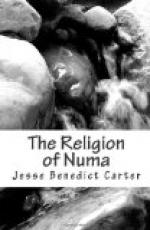The coming of the god of healing in the opening years of the third century may well be regarded as an omen of the great suffering which that century was to bring to Rome. It was a century of almost uninterrupted warfare: first the Samnite war; then the war with Pyrrhus and Rome’s conquest of Southern Italy; then after a breathing spell of about a decade the first war with Carthage, and Rome’s bitter apprenticeship in fighting at sea; then campaigns in Cisalpine Gaul; and finally the war with Hannibal roughly filling the last two decades, the most fearful contest in all Rome’s history, with her most terrible enemy in her own land of Italy. It is little to be wondered at therefore that this was in the main a century of religious depression, a time when the fear of the gods filled every man’s heart and when every trifling apparent irregularity in the course of nature was exaggerated into a portent declaring the wrath of the gods and needing some immediate and extraordinary propitiation. It is in just such a moment as this in the middle of the century (B.C. 249) that the next recorded instance of new gods occurs. The first war with Carthage was in progress, Rome had just suffered a terrible defeat off the north-western point of Sicily, at Drepana, a defeat all the more hideous because it was supposed to have been caused by the impiety of the Consul Clodius, who, hearing that the sacred chickens would not eat, perpetrated his grim jest by saying “let them drink then instead,” and drowning them all. But to cap it all the wall of Rome was struck by lightning. Then action was necessary and the books were consulted. They ordered that sacrifice should be made to Dis and Proserpina, a black steer to Dis, and a black cow to Proserpina, three successive nights, out on the Campus Martius, at an altar which was called the Tarentum, and that the ceremony should be repeated at the end of a hundred years. Here the myth-makers of later times have been even more busily at work than they were in the case of Aesculapius. The Aesculapius story was fitted out by them merely with a few miraculous details, a few legendary ornaments, but the story of Dis and Proserpina was so covered with their fabrications that it has only recently been freed from them and seen in its true light, and certain phases were so absolutely perverted that there are still a number of very difficult points. To get a clear understanding of the situation we must begin quite a distance back.
Taken as a whole, religious beliefs are among the most conservative things in the world; the individual may grow as radical as you please, but his effect on the general religious consciousness of his time is extremely slight. Occasionally the number of radical individuals grows larger and certain classes of society are affected by their views, but even, in the periods of religious development which we are apt to think of as most iconoclastic, society taken in the large, and on the average of all classes, is




